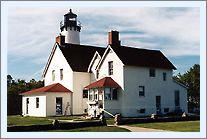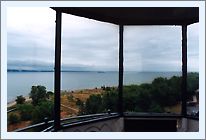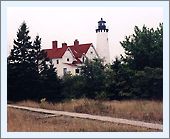|
Historical Information

With the planned opening of the new lock at the Soo in 1855, large
vessels would Finally be able to sail directly from Lake Superior to the
lower lakes, and it was evident that the increase in maritime commerce
would be both dramatic and immediate. While the Light at Whitefish Point
served well to guide vessels around the Point after which it was named,
the location of the entrance to the St. Mary's River remained unmarked,
and it was evident that a light was needed to help funnel vessels into
the river mouth at the southeast end of Whitefish Bay. Congress
appropriated $5,000 for the project on March 3, 1853, and a site was
selected for he station that same year at the northern tip of Iroquois
Point. Iroquois Point had received its name in 1662 after the local Ojibwa
encountered a band of intruding Iroquois encamped on the Point. The
following morning both groups were in a full-pitched battle, and by the
end of the day, the entire band of Iroquois had been wiped-out and the
Point named for eternity.
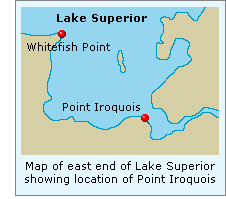 Plans for the station were drawn-up and
arrangements commenced for the purchase of the selected reservation.
Construction began in 1855, and was completed the following year.
Consisting of a 45 foot tall rubble stone tower with a wooden lantern
deck, the tower was outfitted with a flashing white Fourth Order Fresnel
lens. As a result of its location on the highest ground on the Point,
the Light had a 63-foot focal plane, and a range of visibility of 10
nautical miles in clear weather. Little is known about the dwelling at
this station, however it is likely that it too was of rubble stone
construction, and was detached from the tower, as was frequently the
case with such stations built at this time. Charles Caldwell, who had
served for a year as the assistant keeper at Whitefish Point, was
transferred-in as the station's first keeper, and exhibited the light
for the first time on the night of June 8, 1856. Plans for the station were drawn-up and
arrangements commenced for the purchase of the selected reservation.
Construction began in 1855, and was completed the following year.
Consisting of a 45 foot tall rubble stone tower with a wooden lantern
deck, the tower was outfitted with a flashing white Fourth Order Fresnel
lens. As a result of its location on the highest ground on the Point,
the Light had a 63-foot focal plane, and a range of visibility of 10
nautical miles in clear weather. Little is known about the dwelling at
this station, however it is likely that it too was of rubble stone
construction, and was detached from the tower, as was frequently the
case with such stations built at this time. Charles Caldwell, who had
served for a year as the assistant keeper at Whitefish Point, was
transferred-in as the station's first keeper, and exhibited the light
for the first time on the night of June 8, 1856.
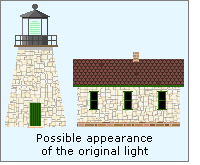 It would appear that the materials and
workmanship employed during construction were less than desirable, and
after only twelve years the District Inspector reported that he found
both the tower and dwelling to be in poor condition in 1867, making
special note that the wooden lantern deck on the tower was in danger of
collapse, and needed to be replaced with a more substantial and durable
iron gallery. In his report for the following year, he found the
situation had deteriorated even further, and while he ordered some
necessary repairs, he went on to state that it was his belief that the
only viable remedy for the situation was the complete replacement of
both structures. However, feeling unqualified to make such an expensive
engineering judgment, he recommended that no decision be made until
"the structures are examined by competent persons." It would appear that the materials and
workmanship employed during construction were less than desirable, and
after only twelve years the District Inspector reported that he found
both the tower and dwelling to be in poor condition in 1867, making
special note that the wooden lantern deck on the tower was in danger of
collapse, and needed to be replaced with a more substantial and durable
iron gallery. In his report for the following year, he found the
situation had deteriorated even further, and while he ordered some
necessary repairs, he went on to state that it was his belief that the
only viable remedy for the situation was the complete replacement of
both structures. However, feeling unqualified to make such an expensive
engineering judgment, he recommended that no decision be made until
"the structures are examined by competent persons."
After a visit to the site in 1869, the
Eleventh District Engineer concurred with the Inspectors previous
observations. Finding that the deterioration of both the tower and
dwelling were so advanced that he recommended that no repairs be made
beyond those required to make the buildings habitable until both
buildings could be replaced, since replacement would be more cost
effective than repair in the long run. Estimating that the two new
structures could be built for $18,000, the Lighthouse Board recommended
that Congress make the necessary appropriation in its annual report for
that same year. Congress evidently concurred, since a work party arrived
at Point Iroquois with the necessary materials the following spring, and
worked throughout the season of navigation building the new tower and
dwelling.
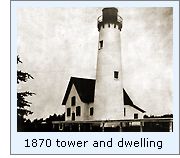 With construction drawing to completion
in the fall of 1870, the new brick tower stood seventeen feet in
diameter at the base, and 50 feet in height from the limestone
foundation to the bottom of the iron gallery. A prefabricated cast iron
spiral stairway with 72 steps wound within the tower, supported by a
hollow central iron column. Capped with a decagonal cast iron lantern
housing the Fourth Order Fresnel from the original tower, exhibiting the
station's characteristic white flash every 30 seconds. The tower's
location atop high ground on the Point provided the lens with a focal
plane of 72 feet, and a resulting 15 mile visible range during clear
weather. The two-story single family brick keepers dwelling was built over a full
basement, and attached to the tower by way of a narrow covered brick
walkway to provide the keeper with welcome shelter as he tended the
light during foul weather. A wood frame barn and brick outhouse
completed the station's complement of buildings. With construction drawing to completion
in the fall of 1870, the new brick tower stood seventeen feet in
diameter at the base, and 50 feet in height from the limestone
foundation to the bottom of the iron gallery. A prefabricated cast iron
spiral stairway with 72 steps wound within the tower, supported by a
hollow central iron column. Capped with a decagonal cast iron lantern
housing the Fourth Order Fresnel from the original tower, exhibiting the
station's characteristic white flash every 30 seconds. The tower's
location atop high ground on the Point provided the lens with a focal
plane of 72 feet, and a resulting 15 mile visible range during clear
weather. The two-story single family brick keepers dwelling was built over a full
basement, and attached to the tower by way of a narrow covered brick
walkway to provide the keeper with welcome shelter as he tended the
light during foul weather. A wood frame barn and brick outhouse
completed the station's complement of buildings.
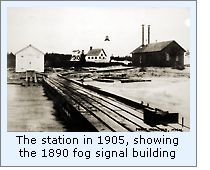 In order to allow the station to serve
during periods of thick weather, a stand-alone bell tower was erected at
the station in 1885, with the bell struck by a Stevens automatic bell
striking apparatus. However, the bell was not destined to serve long at
Iroquois Point, since plans were drawn up to replace it with a pair of
10-inch steam whistles in early 1890. Contracts for the materials for
the new fog signal building and machinery were awarded, and the
materials delivered to the Detroit lighthouse depot by the supplying
contractors. The materials were then loaded onto the lighthouse tender
AMARANTH along with a work party and transported up Lake Huron and
through the Soo lock to Point Iroquois. Construction of the new fog
signal building, and the installation of the steam power plants and
whistles was completed that fall. The whistle controls were adjusted to
ensure that the whistles conformed to the station's prescribed repeated
characteristic of a five-second blast followed my twenty-five seconds of
silence, and the new signal was officially placed into service on
October 31, 1890. With a significant increase in the workload
represented by the new fog signal, James Lasley Jr. was appointed to the
position of acting assistant keeper on November 20, moving into the
cramped dwelling with head keeper Edward Chambers and his family. In order to allow the station to serve
during periods of thick weather, a stand-alone bell tower was erected at
the station in 1885, with the bell struck by a Stevens automatic bell
striking apparatus. However, the bell was not destined to serve long at
Iroquois Point, since plans were drawn up to replace it with a pair of
10-inch steam whistles in early 1890. Contracts for the materials for
the new fog signal building and machinery were awarded, and the
materials delivered to the Detroit lighthouse depot by the supplying
contractors. The materials were then loaded onto the lighthouse tender
AMARANTH along with a work party and transported up Lake Huron and
through the Soo lock to Point Iroquois. Construction of the new fog
signal building, and the installation of the steam power plants and
whistles was completed that fall. The whistle controls were adjusted to
ensure that the whistles conformed to the station's prescribed repeated
characteristic of a five-second blast followed my twenty-five seconds of
silence, and the new signal was officially placed into service on
October 31, 1890. With a significant increase in the workload
represented by the new fog signal, James Lasley Jr. was appointed to the
position of acting assistant keeper on November 20, moving into the
cramped dwelling with head keeper Edward Chambers and his family.
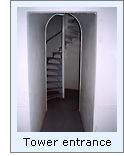 Since the construction of the new
station, lamp oil had been stored in a room designated for the purpose
in the basement. This had been a wholly acceptable practice when whale
oil was used as the primary illuminant, since it was not particularly
volatile. However, with the conversion to the more flammable kerosene, a
number of fires were experienced in dwellings around the country, and
the Lighthouse Board embarked on a project to install stand-alone
fireproof oil storage buildings at all stations throughout the system.
To this end, a circular prefabricated iron oil storage building was
shipped to the station, and erected a safe distance from the dwelling in
1893. No longer serving any purpose, the bell tower was disassembled in
1896, loaded on the lighthouse tender AMARANTH and shipped to Grand
Marais, where it's mechanism was in the Front Range Light currently
under construction. The following year, 448 feet of new concrete
walkways were poured to link the various station buildings, and the
landing dock was rebuilt. Since the construction of the new
station, lamp oil had been stored in a room designated for the purpose
in the basement. This had been a wholly acceptable practice when whale
oil was used as the primary illuminant, since it was not particularly
volatile. However, with the conversion to the more flammable kerosene, a
number of fires were experienced in dwellings around the country, and
the Lighthouse Board embarked on a project to install stand-alone
fireproof oil storage buildings at all stations throughout the system.
To this end, a circular prefabricated iron oil storage building was
shipped to the station, and erected a safe distance from the dwelling in
1893. No longer serving any purpose, the bell tower was disassembled in
1896, loaded on the lighthouse tender AMARANTH and shipped to Grand
Marais, where it's mechanism was in the Front Range Light currently
under construction. The following year, 448 feet of new concrete
walkways were poured to link the various station buildings, and the
landing dock was rebuilt.
1900 saw the replacement of the iron
smoke stacks on the fog signal with brick chimneys, both boilers were
re-tubed and the barn was replaced. The crew returned the following
year, painted the barn, sunk a new well and installed 550 feet of wire
fencing. No doubt 1901 was also a memorable year for keeper Joseph
Bishop and his assistant Otto Bufe, since they were kept busy feeding 28
tons of coal into the hungry fog signal boilers in order to keep the
whistles screaming for a total of 534 hours, an all-time record for the
station.
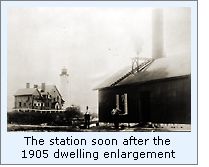 In 1902, Eleventh District Inspector
Commander Edward H. Gheen finally took up the interests of the Point
Iroquois keepers and their families, who had been shoe-horned into the
single family dwelling since the first assistant was assigned to the
station after the fog signal was added in 1890. Estimating that a second
dwelling could be erected for a cost of $5,000, the Lighthouse Board
requested that the necessary appropriation be made in its annual report
for that year. Congress turned a deaf ear to the Board's repeated
requests for three years until 1905, when the funds were finally
approved, and work could proceed. However, rather than building a
separate structure as was originally planned, the decision was made to
expand the existing structure through the addition of a new wing on the
east side of the existing dwelling. A new boathouse was also built and
600 feet of new concrete walks were laid, with the work reaching
completion on November 11, 1905. In 1902, Eleventh District Inspector
Commander Edward H. Gheen finally took up the interests of the Point
Iroquois keepers and their families, who had been shoe-horned into the
single family dwelling since the first assistant was assigned to the
station after the fog signal was added in 1890. Estimating that a second
dwelling could be erected for a cost of $5,000, the Lighthouse Board
requested that the necessary appropriation be made in its annual report
for that year. Congress turned a deaf ear to the Board's repeated
requests for three years until 1905, when the funds were finally
approved, and work could proceed. However, rather than building a
separate structure as was originally planned, the decision was made to
expand the existing structure through the addition of a new wing on the
east side of the existing dwelling. A new boathouse was also built and
600 feet of new concrete walks were laid, with the work reaching
completion on November 11, 1905.
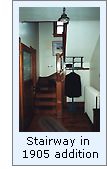 The station's illuminating apparatus
was upgraded from oil wick to incandescent oil vapor on May 3, 1913,
with a resulting increase in intensity from 5,600 candlepower to 42,000
candlepower. At the same time, the characteristic of the light was
changed by decreasing the duration of the light's flash to 6.7 seconds
with a corresponding increase in the duration of the eclipse. Not
content with this change, the characteristic was again modified on June
13, 1922 by a further reduction of the light's cycle to only 4 seconds,
with a flash of only 0.8 seconds duration. The station's illuminating apparatus
was upgraded from oil wick to incandescent oil vapor on May 3, 1913,
with a resulting increase in intensity from 5,600 candlepower to 42,000
candlepower. At the same time, the characteristic of the light was
changed by decreasing the duration of the light's flash to 6.7 seconds
with a corresponding increase in the duration of the eclipse. Not
content with this change, the characteristic was again modified on June
13, 1922 by a further reduction of the light's cycle to only 4 seconds,
with a flash of only 0.8 seconds duration.
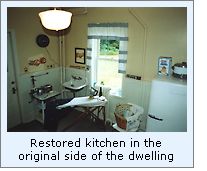 The 10-inch steam whistles were removed
from the fog signal building in 1926, and replaced with a pair of air
compressed air operated Type F diaphone
fog signals. Twin diesel-powered
electrical generators were installed in the fog signal building to
provide power for the compressors, and the fog signal characteristic was
changed to a repeated cycle consisting of a 2-second blast followed by
28 seconds of silence. The diaphones represented a considerable
improvement over the steam whistles, since they were not only louder and
easier to maintain, but could be quickly sounded when needed, without
having to wait for boilers to build up a head of steam. With the
installation of the electrical generators, power was run to the dwelling
and the lamp itself, which was replaced with an incandescent electric
bulb which boosted the intensity of the light to an impressive 82,000
candlepower. The 10-inch steam whistles were removed
from the fog signal building in 1926, and replaced with a pair of air
compressed air operated Type F diaphone
fog signals. Twin diesel-powered
electrical generators were installed in the fog signal building to
provide power for the compressors, and the fog signal characteristic was
changed to a repeated cycle consisting of a 2-second blast followed by
28 seconds of silence. The diaphones represented a considerable
improvement over the steam whistles, since they were not only louder and
easier to maintain, but could be quickly sounded when needed, without
having to wait for boilers to build up a head of steam. With the
installation of the electrical generators, power was run to the dwelling
and the lamp itself, which was replaced with an incandescent electric
bulb which boosted the intensity of the light to an impressive 82,000
candlepower.
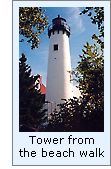 With improvements in RADAR, radio
navigation and LORAN-C in the late 1950's many of the nation's lights
quickly became obsolete. After Point Iroquois Lighted Buoy 44 was
installed offshore in 1962, the Point Iroquois Light was discontinued.
In an event to reduce operating costs, the Coast Guard transferred
ownership of the station to the U. S. Park Service in 1965, with the
property incorporated into the Hiawatha National Forest. No longer
serving any purpose, the station's Fourth Order Fresnel was removed from
the lantern later that year after more than a century of faithful
service to lake Superior mariners. The lens was carefully disassembled
and crated-up, and shipped to Washington DC, where it was placed on
display at the Smithsonian Institution. With improvements in RADAR, radio
navigation and LORAN-C in the late 1950's many of the nation's lights
quickly became obsolete. After Point Iroquois Lighted Buoy 44 was
installed offshore in 1962, the Point Iroquois Light was discontinued.
In an event to reduce operating costs, the Coast Guard transferred
ownership of the station to the U. S. Park Service in 1965, with the
property incorporated into the Hiawatha National Forest. No longer
serving any purpose, the station's Fourth Order Fresnel was removed from
the lantern later that year after more than a century of faithful
service to lake Superior mariners. The lens was carefully disassembled
and crated-up, and shipped to Washington DC, where it was placed on
display at the Smithsonian Institution.
The station buildings were thereafter
leased to the Bay Mills-Brimley Historical Research Society, which
completed a total restoration of the building in 1983. Much of the
station has been converted into an excellent maritime museum, and is
open to visitors from Memorial Day through October 15, and is well worth
visiting.

Keepers of this
Light

Click here
to see a complete listing of all Point Iroquois Light keepers compiled
by Phyllis L. Tag of Great Lakes Lighthouse Research.

Seeing this Light

We arrived at Point Iroquois at 4.00pm,
just before the main building, of which approximately 50% has been
carefully restored, was closing for the day.
There is an excellent display of contemporary photographs of the
families that called the station home through the years. The display is
one of the most interesting that we have encountered, and serves well to
bring the former inhabitants to life. if only for the moment.
At the time of our visit, the entire exterior was being painted, and as
a result the tower was not open to the public. It
took some doing to find vantage points in which scaffolding did not ruin
the view!

Finding this Light

 Take M221 into Brimley and turn left onto 6 Mile Rd. Continue on 6 Mile
Rd. to the lighthouse grounds. Since the lighthouse is part of the
Hiawatha National Forest, there is plenty of parking available. Take M221 into Brimley and turn left onto 6 Mile Rd. Continue on 6 Mile
Rd. to the lighthouse grounds. Since the lighthouse is part of the
Hiawatha National Forest, there is plenty of parking available.
The museum and tower are open to the public every day from Memorial Day
through October 15. Hours are 10.00am to 5.00pm, seven days a week. On
Friday, Saturday and Sunday, they reopen from 7.00pm to 9.00pm.

Contact
information

Point Iroquois Lighthouse & Maritime Museum
Sault Ste. Marie Ranger Office
4000 I-75 Business Spur
Sault Ste. Marie, MI 49783
(906) 635-5311 or (906) 437-5272

Reference Sources

Inventory of Historic Light Stations,
National Parks Service,
1994.
Annual reports of the Lighthouse Board, various, 1853-1909
Annual reports of the Lighthouse Service, various, 1910-1939
Annual reports of the Lake Carrier's Association, various,
1906-1940
Rites of Conquest, Charles E. Cleland, 1992
Email from Russ Rowlett, 06/01/2000
Personal
visits to Point Iroquois on 09/09/1998 & 07/21/2002
Historical photographs courtesy of the Point Iroquois Lighthouse &
Maritime Museum
Aerial photograph courtesy of Marge Beaver of Photography
Plus
Photographs from author's personal collection.
Keeper listings for this light appear courtesy of Great
Lakes Lighthouse Research
|
